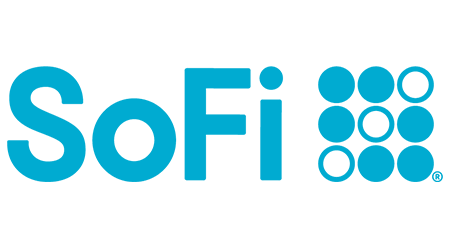
- 0.50% APY on checking balance
- Up to 3.80% APY on savings
- $0 account or overdraft fees
- Get up to a $300 bonus with direct deposits of $5,000 or more
Serbia is home to mountains, monasteries, vampires (well, maybe), raspberries and an edgy nightlife scene. This Balkan nation is a growing destination for tourists, but remember your cash — especially if your wanderlust leads you to the vineyards or mountains like Fruska Gora. Serbians rely on cash more than other countries in Western Europe, using the Serbian dinar as their main payment method.
Visa and Mastercard credit cards are accepted by most hotels and shops in major cities and at ATMs. Go with a travel credit card in hand to avoid pesky foreign transaction fees. You’ll also find banking services in Belgrade and other large cities modern and safe — however, you may have problems using your cards for purchases and ATMs outside the big cities.



Most major credit cards are accepted by merchants in major cities like Belgrade. And you’ll easily find ATMs that support both credit card and debit cards. However, once you leave the big cities, be sure you have cash on hand. You won’t always find vendors that take credit.
Wait until you arrive in Serbia to exchange your USD. Exchange companies in the US charge high commissions, taking a cut of what could go a long way in Serbia. You’ll find exchanges at the airport and in the cities or in banks — all offering about the same rate.
There are no travel cards that support Serbian dinars. If you’re traveling through Europe using your travel card, be sure to find one that waives the currency conversion fee when you spend in dinars.
Pick a variety of ways to access and spend your money while you’re in Serbia so that you have options. A credit card is a convenient line of credit you can use on your vacation, while a debit or prepaid travel card is a good option when you want to make ATM withdrawals.
Travel credit cards give you a line of credit to use for emergencies, large purchases or over-the-counter transactions. Find yourself a credit card that waives foreign transaction fees, such as the Capital One VentureOne Rewards Credit Card (Terms apply, see rates & fees).
Cards that offer travel perks and waive fees often charge an annual fee, so make sure the fee is worth it before you bring it along on your travels.
A travel debit card lets you spend your own money through ATM withdrawals and make purchases anywhere Visa or Mastercard are accepted. The Betterment Checking, for instance, keeps your pockets padded by reimbursing international foreign transaction and ATM fees. You can use a debit card over the counter and to withdraw money from ATM. Because you’re spending your own money, you avoid interest charges you’d pay with credit cards.
No travel cards support Serbian dinar, so look for a card that waives the currency conversion fee, such as Travelex, if you’re set on taking a travel card. It won’t apply the additional charge for currency conversion when you spend in dinar, which can be higher than what you’d pay if you use your regular debit or credit card.
The compromise is it charges you to use an international ATM withdrawal in Serbia, which is a couple of dollars for each withdrawal. You can load these cards with euros to use at some merchants— but don’t count on it. And you won’t get the best exchange rate. The benefit of a prepaid card is that they let you lock in the exchange rate when you load your funds. However, they often don’t charge as competitive exchange rates as credit cards and debit cards.
Once you arrive in Serbia, look for a bank or exchange office to exchange your dollars for dinar. There are also money exchange machines that are open 24 hours a day. They take euros, sounds and US dollars and exchange up to $200 at a time. Though travel, debit and credit cards are accepted in the cities, you’ll likely need cash if you’re shopping at smaller vendors or markets. You will need dinars in Serbia; petrol stations near the borders may take euros at an unfavorable exchange rate.
If you bring traveler’s checks, you can cash American Express and Visa issued checks at most banks. Though, don’t try to use them in stores as they won’t accept them. Traveler’s checks have been replaced by credit cards and travel cards.
The USD has grown significantly against the RSD in the past 10 years. Watch the forex markets and determine a good time to buy dinars and lock in a favorable rate with traveler’s checks.
Live Rate
Refreshing in: 60s | Fri, Mar 28, 07:14 PM GMT
Your options are limited if you want to purchase dinars in the US — wait until you arrive in Serbia. Because dinar is considered an exotic currency, it can be hard to find in the US, and the rates and commission is higher than in Serbia.
The official currency in Serbia is the Serbian Dinar RSD and comes in denominations of 10, 20, 50, 100, 200, 500, 1000 and 5000 dinars, each a different color. Be sure to pay the right amount when you make your purchases, and always count your change. Familiarize yourself with what the currency looks like and how it works will avoid confusion when handling your money.
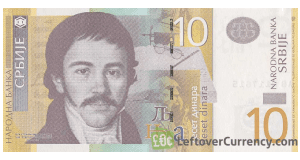 | 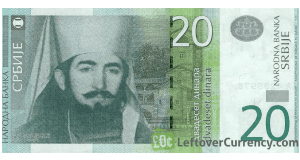 | 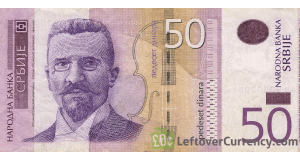 |
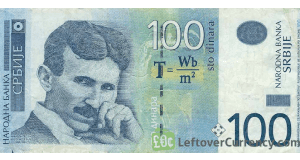 | 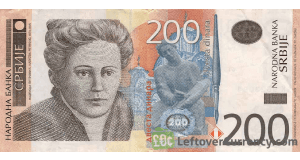 |
You can easily find ATMs in Belgrade and at the airport as well as in local post offices. However, the further you go toward the mountains and rural areas, the less you’ll find ATMs at your convenience. When stashing up on cash before exploring the country, go with a Betterment Checking account and debit card to get those pesky international ATM fees reimbursed within 24 hours.
Travel to Serbia and the Balkans is cheaper than most countries in Western Europe. Budget travelers can find food, entertainment and a dorm bed for under $15 a day. Mid-range travelers can travel for under $30 a day, and luxury travelers can live it up for under $80 a day. All prices are in US dollars.
| Belgrade | Budget | Mid-range | Expensive |
|---|---|---|---|
Accommodation | Hostel dorm bed: $4–$10 per night | 3-star hotel: $10 per night | 5-star hotel: $20–$50 per night |
Meals | Lunch at a small Serbian grill: $3–$6 per item | Lunch at a pizza & pasta restaurant in the city: $5–$10 per dish | Fine dining. 5-star restaurant: $15–$20 per main |
Activities | Downtown Belgrade walking tour: Free | Section 1 seats for the opera at the Serbian National Theatre, Belgrade: $15 | Private guided food tour: $150 per person |
Prices are approximate and are subject to change.
Victor and Salome went to Serbia’s famous EXIT electronic music festival in the Petrovaradin Fortress, Novi Sad, near Belgrade. They’d just come from Hungary and the festival was only a short stop on a longer trip through Europe. They arrived in Belgrade and took a train to Novi Sad. We interviewed them to see what experiences they had using travel money while in Serbia.
Do you have any tips?
Have a look at the Belgrade Pass. It gives you discounts on admission to museums, discounts on dinner at selected restaurants, hotels, hostels, car rental and a comprehensive city guide for $15, says Victor. Salome adds that you should always tell your bank when you’re leaving the country. Otherwise, they may block your cards if they see an overseas transaction.
How to pay, how much to bring and travel money suggestions for your trip to USA.
How to pay, how much to bring and travel money suggestions for your trip to New Zealand.
How to pay, how much to bring and travel money suggestions for your trip to Thailand.
How to pay, how much to bring and travel money suggestions for your trip to Vietnam.
How to pay, how much to bring and travel money suggestions for your trip to Mexico.
How to pay, how much to bring and travel money suggestions for your trip to Portugal.
How to pay, how much to bring and travel money suggestions for your trip to Germany.
How to pay, how much to bring and travel money suggestions for your trip to Ecuador.
How to pay, how much to bring and travel money suggestions for your trip to Canada.
How to pay, how much to bring and travel money suggestions for your trip to Japan.